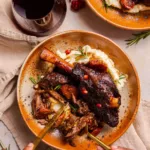Pomegranate Braised Lamb Shanks
This dish, Pomegranate Braised Lamb Shanks, is really tasty and satisfies all cravings. Shanks of lamb so tender they break apart and are cooked in a rich, flavorful sauce scented with pomegranate until they are completely cooked through. You will adore this meal, which is full of taste and worthy of a restaurant! Serve your preferred sides with these tender lamb shanks for a satisfying supper that the whole family will love!
Yield: 5
Materials
- 4 –5 lamb shanks excess skin trimmed as needed
- kosher salt & freshly ground black pepper to taste
- 2 tablespoons vegetable oil plus more as needed
- 3 shallots cut into wedges
- 2 large carrots chopped
- 6 cloves of garlic crushed
- 2 tablespoons all-purpose flour
- 1 tablespoon packed light or dark brown sugar
- 1/2 teaspoon smoked paprika
- 1/2 teaspoon ground cumin
- 1/2 teaspoon ground allspice
- 1/2 teaspoon red pepper flakes
- 1/2 teaspoon curry powder
- 1/4 cup balsamic vinegar
- 2 cups pomegranate juice
- 1 1/2 cups beef stock or broth
- 3 –4 rosemary sprigs
- 2 bay leaves
- pomegranate arils for garnish– optional
Instructions
- Season and rest the lamb by using paper towels to pat the shanks dry. Season the lamb shanks on all sides with a sufficient amount of salt and pepper and place them on a big plate or baking sheet. Give the lamb shanks at least 20 minutes to sit and thaw at room temperature. Then, set the oven temperature to 325°F.
- To brown the lamb shanks, preheat the oil in a deep braiser or a large Dutch oven (at least five quarts in size and oven-safe) over medium-high heat. To uniformly coat the bottom, gently swirl the pot once the oil begins to shimmer. Working in batches and taking care not to overcrowd, add a couple lamb shanks to the pot. The shanks should be seared for two to three minutes on each side, or until a deep brown crust forms. Once all of the shanks are done, transfer them to a clean plate or small baking sheet and continue cooking until the remaining shanks are browned. After that, remove the browned shanks and turn down the heat to medium.
- Add the shallots and carrots to the saucepan and sauté the aromatics. The mixture should be sautéed, stirring occasionally. Add salt and pepper to taste. For around 4–5 minutes, or until the food is soft and golden brown, keep sautéing. After that, add the garlic and simmer for an additional one to two minutes, or until fragrant. When sautéing, if the mixture seems dry, add a little extra oil to the pot, but only as much as is needed.
- Combining the flavors: To coat, stir the mixture after adding the flour and stirring. Cook for one to two minutes, or until the flour disappears and starts to get a light brown color. Stir to thoroughly mix in the brown sugar, curry powder, cumin, allspice, smoked paprika, and red pepper flakes. Give the spices a good minute or two to toast. Next, deglaze the saucepan with the balsamic vinegar and scrape off any caramelized pieces from the bottom of the pot with a wooden tool.
- Put together the braise: Pour back the remaining fluids that have gathered into the saucepan together with the browned lamb shanks. Add the beef stock or broth and pomegranate juice; the shanks should be nearly fully covered by the liquid. Add the bay leaves and rosemary sprigs to the saucepan and whisk everything together gently. After raising the heat to medium-high and boiling the pot for around five minutes, remove from the burner.
- To braise the lamb shanks, place a cover on the saucepan and put it in the oven. Leave the lamb shanks covered to braise for three hours. After 30 minutes of braising, take off the lid, baste the shanks with the braising liquid, and continue cooking until the flesh pulls away from the bone and the shanks are extremely soft.
- If necessary, adjust the braising liquid: Remove the saucepan from the oven with caution. Take out the bay leaves, herb stems, and cooked lamb shanks from the saucepan. When necessary, skim any fat from the liquid's surface. Place the saucepan on the burner over medium-high heat to thicken the braising liquid. Cook for a little while, stirring gently, until the liquid decreases and becomes more syrup-like, coating the back of a spoon.As an alternative, you can thicken by simmering a cornstarch slurry (1 tablespoon cornstarch plus 1 tablespoon water). After that, taste and add extra salt or pepper to suit.
- Serve these lamb shanks with pomegranate braising sauce right away. Serving these shanks in shallow bowls with creamy mashed potatoes and spoonfuls of the braising sauce poured over everything is my favorite way to serve them. If desired, garnish the completed dish with pomegranate arils. Have fun!
Notes
- Please read the blog post in its entirety for more tips + tricks.
